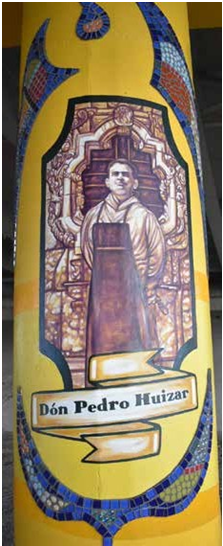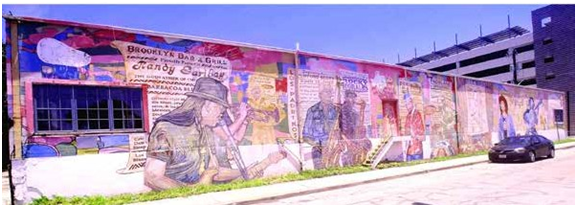David Blancas
Muralist and Painter

By Dr. Ricardo Romo
San Antonio’s West- side is home to some of the city’s most vibrant cultural murals. The mural movement that began at the Cassiano homes nearly forty years ago has spread to other parts of the Westside and now to the Southside. How- ever, multiple years under a burning Texas sun have not been kind to the older murals.
 David Blancas is one of the many artists who intend to change that. Blancas, as well as members of the San Anto Cultural Arts, are making sure that there is a balance between painting new murals and restoring older faded murals.
David Blancas is one of the many artists who intend to change that. Blancas, as well as members of the San Anto Cultural Arts, are making sure that there is a balance between painting new murals and restoring older faded murals.
It is fitting that David Blancas is about to begin the restoration of the Musicos mural on the western reach of the Westside, a mural that he originally painted in 2009. Located on Commerce Street near the Colorado Street in- tersection, the Musico mural was the 37th mural project of the San Anto Cultural Arts.
Blancas’ grandfather and father were musicians both earning a living performing with trios in Mexico and the United States. Blancas moved to the United States from Nueva Rosita, Coahuila when he was two years old. As a child, Blancas developed a deep-seated interest in painting and drawing. He attended San Antonio Highlands High School and studied art at UTSA. Blancas’ dedication paid off in his early twenties when he entered and won two national Hispanic arts competitions in 1997 and 2001 respectively. Today, Blancas is confident about his artistic path. He writes: “My passion for historical and cultural themes is a recurring component of my studio, exhibition, and public art projects. My experience with various forms of media is demonstrated in bodies of work which include abstract conceptual work, sculptural 3 dimensional installations, and modern mural fabrication and installation processes.”
The restoration of the “Musicos” mural is just getting underway and will engage him for five months. Thanks to the pioneering work of the Philadelphia Mural Arts Program, the restoration work will largely take place in his studio. The mural will be painted on textile panels and then glued to the exterior wall of the Commerce Street building.
The Philadelphia Arts model was successfully ap- plied to a mural at Harland- ale High School. The Harlandale Class of 1955 funded the mural which linked the school to the Missions of San Antonio’s southside.
A press release on the Musicos mural restoration project acknowledged the “piece is a commemorative mural project which pays homage to the lives and music of Randy Garibay, Clifford Scott, Rocky Mo- rales, Felix Villareal, Manny Castillo, Eva Garza, Doug Sahm, Valerio Longoria, Lydia Mendoza, and Rosita Fernandez. “
I am most familiar with the last four performers. Growing up in the 60s in the Westside I listened to and danced to the music of Doug Sahm, as well as Sonny and the Sunliners and the Royal Jesters. I have also enjoyed the accordion music of the legendary Valerio Longoria, Santiago Jimenez, Flaco Jimenez, and Estevan Jordan. My parents followed the musical careers of Lydia Mendoza and Rosita Fernandez whose music dates back to the 1940s.
RAL 10 YEAR ANNIVERSARY

Updated Concept Rendering
All of these musicians have had a profound influence on the musical heritage of San Antonio. Their creative influence is woven into the fabric of San Antonio’s mu- sical identity and has long been representative of the Westside of San Antonio. Blancas’ project is supported by Westside Development Corporation (WDC), San Anto Cultural Arts (SACA), Alamo Colleges Westside Education and Training Center, and La Printeria.
David Blancas has an ex- cellent track record in mural painting in San Antonio. His most recent work includes painting 88 colorful concrete pillars under Highway 90 at Roosevelt Ave. Each pillar celebrates Latino history and the culture of San Antonio and Texas. For example, one mural celebrates the life of Emma Tennayuca, the San Antonio pecan sheller labor leader of the 1930s.
Among the Highway 90 paintings, I took a special interest in the mural dedi- cated to Don Pedro Huizar, one of Texas’ first artisans. I wrote about Huizar for my recent essay in the Art of Texas book sponsored by the Witte Museum. I consulted historical studies that utilized church records from the San Jose Mission and journals written by the Spanish explorers and the ac- companying friars, as well as records in the Bexar County Archives. These records and studies allow us to trace the arrival of Huizar and other Mestizo artisans to Texas.
The first architectural designs and sculptures of the missions along the San Antonio River, especially at San José, are attributed to Antonio Salazar and Pedro Huizar.
Salazar, born in 1730 in Zacatecas, Mexico, is recognized by art historians as a sculptor, master mason, and architect. He is, without doubt, Texas’ earliest arti- san. There are ample myths and much controversy about the birthplace and personal life of Pedro Huizar (1740- 1804).
According to historian Rebecca Green, “Over two centuries, Huizar gained notoriety within the oral tra- dition as the sculptor of the facade and Rose Window of San José.” Many scholars claimed that Huizar was born and trained in Spain and created the Rose window in memory of a woman he had left behind in Spain who had lost her life while crossing the Atlantic to meet up with him. Huizar is said to have died of a broken heart.

Current Condition
Over the last two decades, we have learned much about Huizar. According to the Texas State Historical Association, Huizar (1740- 1804) was actually born in Aguascalientes, Mexico, and arrived in San Antonio sometime before 1775. He married Maria de la Trinidad in 1775 and they had seven children.
Huizar was commissioned to work on the façade of San José mission and also sculpted the church’s rose window. Huizar not only worked as a mason at San José Mission, but he also bought land in the surround- ing area and eventually was appointed as a local judge. He died a natural death at age sixty-four. I recently learned from Blancas that Huizar’s great-great-great- grandchildren still live in the area surrounding San Jose Mission on the land once owned by their ancestors, Don Pedro Huizar.
The tragic events of El Paso, Texas last week re- mind us that too many of our fellow citizens still consider all Latinos as recent immigrants. When friars and Mestizo soldiers founded San Antonio in 1718, they were joining the first Americans, native indigenous people, in the establishment of frontier settlements.
In many frontier instances, new settlers fought with the native people, but in San Antonio, they joined hands to build a community. In perhaps the first mural or painting of Huizar in Texas, the mural of Blancas recognized the work of Don Pedro Huizar and acknowledges the importance of knowing and understanding Latino history in this region, which began before the Mayflower arrived.
Blancas notes that “Public art can inspire and engage an individual in a visual dialogue. What that narrative may involve is up to the artist. Each project represents a wonderful opportunity to have a positive impact on the cultural texture and creative landscape of a community.” I agree, and we wish him well in his new project to re- store the Westside mural that celebrates the great musicos of Texas.






